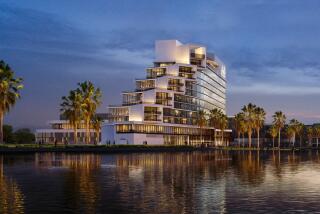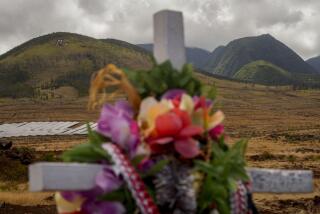Some Big Projects Set for Hawaii’s Big Island
- Share via
KAILUA-KONA, Hawaii — The only thing bigger than the construction boom on the west coast of the Big Island of Hawaii is the talk of all the projects on the drawing boards.
This is, after all, the biggest of the state’s islands, at 4,050 square miles more than twice the size of all the others combined. A little Texas-size bragging is to be expected on an island that has cattle ranches that wouldn’t be out of place in Texas.
The biggest and most controversial project on the Kona-Kohala coast that extends for more than 50 miles north of Kailua-Kona is the $360-million, 62-acre Hyatt Regency Waikoloa resort, scheduled to open next September.
The second major hotel on the 31,000-acre Waikoloa resort area--the first was the Sheraton Royal Waikoloa--it will have 1,244 rooms in three low-rise buildings connected by monorails and gondolas that bring to mind Disneyland or Walt Disney World in Orlando, Fla.
Canals, Waterfalls, Lagoon
It will have more than a mile of waterways, featuring canals, waterfalls and a seven-acre lagoon.
All this has the imprint of Christopher B. Hemmeter, the developer of Hemmeter Center in Waikiki, the Hyatt Regency Maui at Kaanapali and the just-opened Westin Kauai at Kauai Lagoons near Lihue on the island of Kauai.
The official development arm of the resort is Transcontinental Development Co., Honolulu, a partnership of Santa Barbara’s Transcontinental Corp., the Bass family interests of Fort Worth, Chicago’s Hyatt Corp., KGS Waikoloa Investment and the Hemmeter Investment Co. of Honolulu.
Fred T. Yamashiro, director of administration for the project, said that many of the design elements of the resort were inspired by Disney World, although the architect of record is Lawton, Unemura & Yamamoto Architects AIA, Honolulu.
Fourteen restaurants and lounges will serve guests of the luxury resort. There will be eight tennis courts, golf, racquetball and enough meeting rooms and convention facilities for the fairly large gatherings befitting the largest hotel in the state outside Waikiki.
As if this isn’t big enough, the existing Waikoloa resort master plan calls for a total of 3,000 hotel rooms, including the 1,244 of the Hyatt and the 534 of the Sheraton Royal Waikoloa that opened in 1981.
Fifteen miles north of Waikoloa on Highway 19 is Kohala Ranch, a totally different world of large lots and white fences, expensive custom houses, arena polo and riding trails.
So far, 158 parcels have been sold of 223 available in the first phase, according to John Michael White of Hawaii Land Management, the brokers for Kohala Ranch. The nearly 4,000-acre project features three- to 10-acre fee-simple parcels priced from about $135,000 to nearly $400,000, he said.
Fully 25% of the buyers are from Southern California, White’s native region (he grew up in Burbank and Glendale and was graduated from Glendale’s Hoover High School).
Michael Dodds & Associates, 3401 Cahuenga Blvd. West, Los Angeles, is the exclusive California marketing agent for the development, White said.
Harry H. Otsuji, Honolulu-based project manager for Kohala Ranch, a joint venture of Oxford First Corp., Philadelphia, and Hudson General Corp., Great Neck, N.Y., said that another 25% of the buyers are from Hawaii. The balance come from around the nation, with relatively few foreign buyers.
Security Gates expected
The development has security gates on the makai (ocean) side and the mauka (mountain) side, largely because such amenities are expected for high-end developments in Hawaii, White and Otsuji agreed.
Virtually all of the condominium developments within resorts such as Mauna Lani Bay, owned primarily by the Tokyu Group of Japan, and Mauna Kea, originally developed by Laurance Rockefeller in the mid-1960s, and now owned by a subsidiary of UAL Inc., have security gates guarding the condos.
“We’re not talking about a crime wave or anything,” White said. “It’s just the expected thing for buyers of luxury properties in places as diverse as Palm Springs, Pebble Beach or Hawaii.”
The Mauna Lani Point condominiums--priced from $300,000 to $895,000 and ranging in size from 1,306 to more than 2,500 square feet--are typical of the housing being produced on the Kona-Kohala coast, he said.
Commute Long Distances
Otsuji said that workers in the resorts typically live in “plantation” communities such as Hawi on the island’s northern tip, Honokaa on the northeast coast and the island’s metropolis, Hilo, where nearly half the 110,000 residents of the island live.
“People are used to commuting long distances, but there are only four traffic signals on the island,” he said. “Two in Hilo, one in Kailua-Kona and one in Waimea, also known as Kamuela,” White said.
Buses are used to bring in construction workers on the Hyatt Regency Waikoloa project from Hilo, where more than 700 workers are rushing to meet next September’s deadline. When the resort is completed, it will need about 2,000 workers, according to Yamashiro. Many of these workers will be bused in.
Not even Kona Village Resort, developed in the 1960s, about the same time as the Mauna Kea and famous for its thatched roof hales (bungalows), is immune from the expansion and development of nearly 30 existing and proposed sites on the Kona-Kohala coast.
General manager Fred Duerr, on a golf cart tour of the resort, pointed out the pads for the 25 new hales that will be completed by next spring. This will bring the total to 125, he said.
Kona Village Resort benefits from being the first one north of the Keahole-Kona airport, Duerr said, adding that the “plush/primitive” resort has the highest occupancy rate of any resort in the state, along with room rates of $295-$400 double occupancy that are among the state’s highest.
“We’re expanding, but we’re not changing our character in the slightest,” Duerr said. “We depend on repeat business from free and independent travelers (as opposed to group tours), and our guests typically shun the massive resorts of Waikiki, Kaanapali and the other areas.”
Long-Range View
Makoto (Max) Yuki, president of Mauna Lani Resort Inc., said that the resort’s Japan-based parent firm, the Tokyu Group, plans to keep the resort for a minimum of 20 years.
He said that room occupancy currently averages 72%, just short of the 75% level that ensures profitability. He said that Japanese companies have a long-range view of real estate--especially first-class projects like Mauna Lani--and expect to wait out periods of minimal profitability.
Roger A. Harris, project planner for Mauna Lani Resort, said that 1990 is the projected opening date of the resort’s $60-million Ritz-Carlton Hotel.
The 450-550-room project will be built on a 32-acre site on Pauoa Bay, just north of the existing Mauna Lani Bay hotel, he said. The developer is W. B. Johnson Properties, Atlanta.
Unlike Mauna Kea, where the property is mixed leasehold and fee-simple ownership, all of the 3,200 acres of Mauna Lani are fee-simple land, according to White of Hawaii Land Management. All things being equal, he said, most condominium buyers prefer fee-simple land, so this form of land ownership makes it easier to sell the resort’s 116-unit Mauna Lani Point condominiums, for instance.
“When I sit down and list all the projects that have been proposed for the Kona-Kohala coast, it looks like a lot of development in a small area,” White said.
“But you’ve got to remember that all these developments are spread out over more than 50 miles of coastline and amount to only a tiny percentage of the land area of the Big Island. We’re never going to have another Waikiki or Kaanapali on the Kona-Kohala coast.”
More to Read
Sign up for The Wild
We’ll help you find the best places to hike, bike and run, as well as the perfect silent spots for meditation and yoga.
You may occasionally receive promotional content from the Los Angeles Times.






